| NORTH AMERICAN BABYDOLL SOUTHDOWN SHEEP ASSOCIATION & REGISTRY | ||||
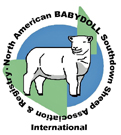 |
 |
 |
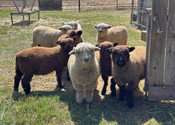 |
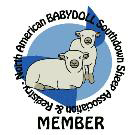 |
| Start your day with a SMILE...Own a BABYDOLL! | ||||
| NORTH AMERICAN BABYDOLL SOUTHDOWN SHEEP ASSOCIATION & REGISTRY | ||||
 |
 |
 |
 |
 |
| Start your day with a SMILE...Own a BABYDOLL! | ||||
In 1780, John Ellman from Glynde, England, took the local sheep known as Southdown and systematically selected, developed and standardized them into what we now recognize as the considerably improved BABYDOLL Southdown; a breed that was destined to make its name a presence in sheep farming across the world because of Master Breeder John Ellman's work. In her book, author Valerie Porter wrote, "John Ellman once said, that it was more difficult to maintain a good breed than to raise it to first class and he bequeathed to today's breeders the challenge of continuing what he began." The NABSSAR agrees with this philosophy and believes that today's breeders should maintain the integrity and work that Mr. Ellman began and continue to honor his work by keeping the Southdown conformation consistent - without crossbreeding or breeding lesser quality animals. Not every BABYDOLL Southdown lamb that is born should be allowed into a breeding program. Breeders must know what characteristics to look for and carefully choose their breeding stock. That is why we at NABSSAR believe that breeders should take the time to educate themselves by carefully reading and learning the breed standard.
When learning about the NABSSAR breed standard, a clear understanding of the difference between the terms: "Discriminated Against" and "Disqualifying" is important. These terms are defined as such:
Please note that when the terms fleece and wool are used, fleece refers to what is on the animal and wool is the product made from the fleece.
BABYDOLL Southdown sheep are known for their docile dispositions. For this reason, they are often kept as pets, but they are also used in a variety of ways such as grass mowers and weed eaters in vineyards and orchards and 4H projects. They are small in stature and are easy to handle. Their small size and efficient metabolism requires less acreage per animal compared to other breeds of sheep. Thus, they are referred to as being "easy keepers." They are excellent mothers and are known for having multiple births. The BABYDOLL Southdown is known for its dense wool and its abundant carcass (relative to its size) and flavorful meat and is crossbred with lighter weight breeds of sheep to produce lambs of higher quality for market. They are also prized for their wool.
The characteristics of the head give each breed its individuality and uniqueness. The BABYDOLL Southdown's head should be wide and level between the ears, with no sign of a dark poll as the BABYDOLL is a polled (hornless) breed. Small, loosely attached or nubby scurs are sometimes seen on rams, which are considered a fault and discriminated against. Solid 1" or larger scurs or horns are a disqualification. The head is medium length and moderately broad, but not so broad to be a birthing obstruction. Extremely broad heads are considered a fault and discriminated against. The ears set level with the head, neither drooping nor so upright they are perpendicular to the ground and should be covered with some degree of fleece.
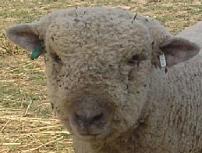
Good head for a young ram. |
The muzzle is the area on the face that is covered with short fuzzy fleece and hair that is a shade from very light tan to brown to cinnamon to mousy gray color in the off-white fleeced sheep and black color in the black-fleeced sheep. The muzzle should be moderate in width to ensure efficient grazing, as well as moderate in length. It should be straight to slightly dished, but not Roman (arched) which is a breed disqualification. The wide muzzle gives the BABYDOLL sheep its classic smiling look and also makes it an efficient grazer.

The classic "BABYDOLL"
Smile |
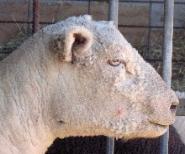
Profile showing a straight nose. |
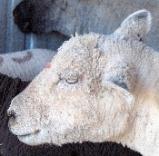
This ewe shows a very
slightly |
In the off-white sheep, the nose/lip leather should be black, dark to light gray or bluish gray. Speckles are common and are acceptable but solid colors are preferred. Please note lambs often are born with pink noses and coloring will come with time. In the black sheep, the nose/lip leather should be solid black, no other color is accepted. A bright solid pink nose/lips, or those without any pigmentation (pale white), are breed disqualifications and the sheep cannot be registered.
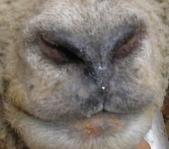 |
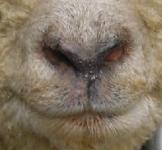 |
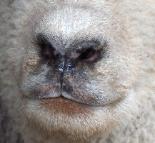 |
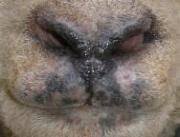 |
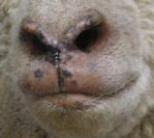 |
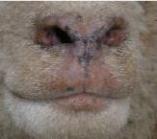 |
 NO! NO!This is an example
of a sheep with a bright solid
pink nose and lips. This
is a breed disqualification.
The sheep is three years old in this photo. If a
sheep has a nose like this as a lamb, wait to register it until you
know if the nose will darken up. The muzzle on this sheep is
also a bright white. If the hair/wool on the legs is also
bright white, this is a disqualification and the sheep cannot be
registered.
|
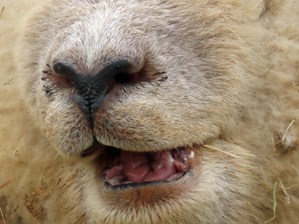 YES! YES!This is an example
of a sheep with a solid black nose and black lips.
This is the preferred color of a BABYDOLL Southdown's nose leather and
lips.
|
The fleece and hair on the muzzle of the black-fleeced sheep should be solid black. Muzzles of black sheep often get scattered gray hairs as they age. In the black sheep, the nose/lip leather should be solid black, no other color is accepted.
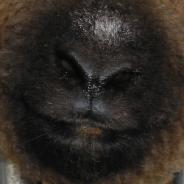 |
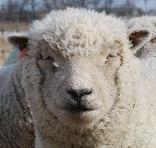 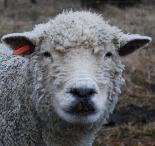
Examples of Open Faces |
 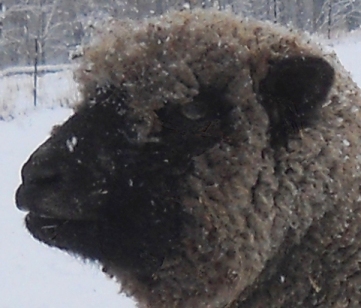
Examples of Average Faces |
||
|
|
|
|
|
|
The sheep pictured above in the bottom row all have overly woolly faces and show different degrees of what is referred to as "wool blind." The fleece and hair covering around the eyes and cheeks to the muzzle should be short and not so thick as to ever cause the sheep to be "wool blind." Tear ducts should not be too woolly. Wool blindness and woolly tear ducts are both faults discriminated against. A conscientious breeder should work on breeding both of these tendencies out of their flock. If your sheep have overly woolly faces, trim the areas around the eyes regularly so they do not become "wool blind." |
|||
The ears should be of medium thickness and moderate in length. They should be level with the poll (top of the head) - neither drooping nor perpendicular to the ground. The size should be in proportion to the head and covered with short wool which can be mixed with short, rough hair. However, slick ears are discriminated against. Black or brown-specked ear skin is common.
The eyes should be large and bright. Acceptable eye color is predominately a shade of yellow to brown. Any other color is a disqualification, the sheep cannot be registered. Entropion, which is inverted eyelids, is discriminated against.
 |
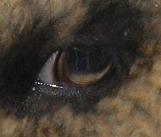 |
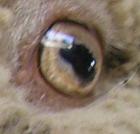 |
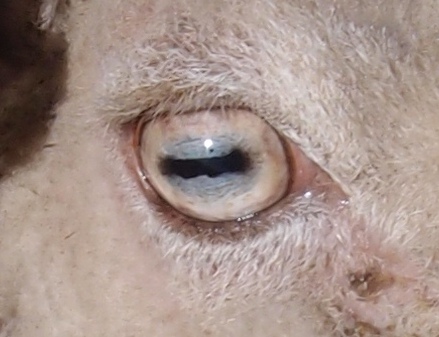 Predominately a shade of yellow but has some blue around the iris. Can be registered. |
 Blue (or any other color). Cannot be registered. Note: This is a photo of a goat's eye. |
The incisor teeth should meet the dental pad. Sheep with a slight under or overbite with teeth just barely touching the edge of the dental pad are discriminated against; whereas, a sheep with a severe under or overbite, with distinct space between teeth and edge of dental pad is a breed disqualification.
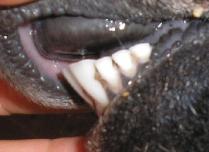 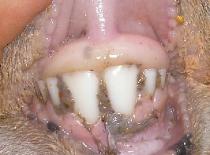
Good adult ewe teeth meeting the dental pad. |
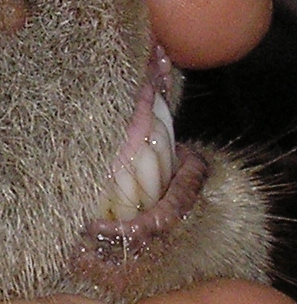
Young lamb with teeth meeting the dental pad. |
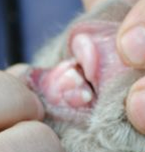 |
An example of an overbite or parrot mouth. The lower jaw set is well behind the dental pad. This fault is a disqualification and this sheep could not be registered because the teeth do not meet the dental pad. | 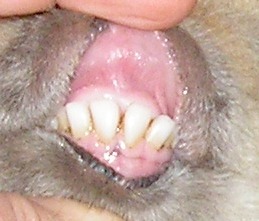 |
An example of an underbite or long lower jaw. The lower jaw extends beyond and in front of the dental pad. This fault is a disqualification and this sheep could not be registered because the teeth do not meet the dental pad. |
| The examples above are bad bites that make a sheep nonregistrable because it is a disqualifying fault. Always check the teeth on any sheep you purchase and all lambs before registering them. This is one very important area people forget about that always needs to be checked. A sheep must have proper alignment of both jaws in order to shear grass properly and efficiently. | |||
| For those of you that have asked, "How can I tell how old a sheep is by looking at their teeth?" Here is a chart that may help you to learn by comparing this chart to your sheep's teeth, guess the age then check yourself with their registration papers to see correct ages and see how close you got. This is a good way to learn. Both of the adult sheep pictured above are yearlings. Note the two larger teeth in front and lamb teeth on the sides. |  |
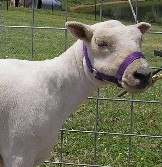 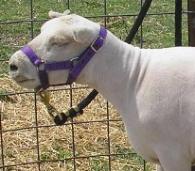 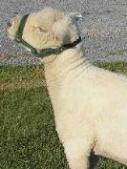
Examples of correct necks. Wrinkles at the bends in the neck are totally acceptable. |
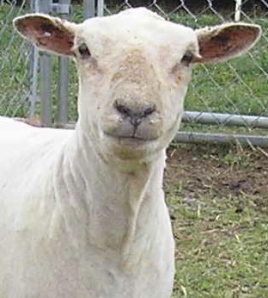 This ewe above is showing some wrinkling of the skin on the underside of the neck. This amount of wrinkling is more than ideal but not considered excessive. If being judged, this would be considered a fault and her neck point score would be lowered. 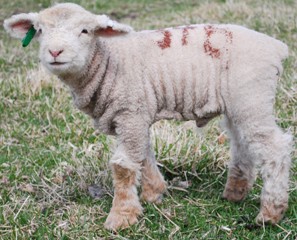 The lamb above is showing excessive wrinkling of the skin. Normally a lamb like this will "grow" into his skin and the wrinkling will disappear as he ages and he will look totally normal as an adult. If, as an adult, he still has several big rolling wrinkles on his neck, he would be faulted. If, as an adult, he still has big rolling wrinkles elsewhere on his body, he would be major faulted. 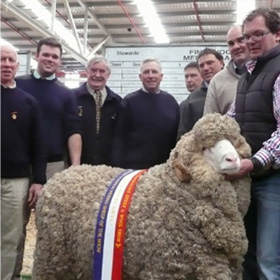
MERINO SHEEP - EXAMPLE OF
ROLLING WRINKLES ON THE NECK
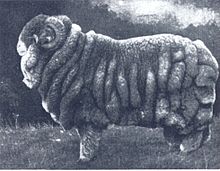 MERINO SHEEP - EXAMPLE OF ROLLING WRINKLES ALL OVER THE BODY |
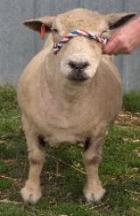
Short and straight legs should stand squarely at each corner of the sheep's body. |
When first learning to judge conformation, it is much easier when a sheep is sheared to see true angles. Fleece growth can be deceiving and make actual straight correct legs look crooked when they are not as one can see by the ewe above pictured sheared and in full fleece. The thick fleece on the upper legs tend to make her legs look as if they bow in when actually they are nice correct legs when seen sheared. |
|||||
| . . . |
||||||
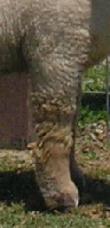
Side view of correct front legs. |
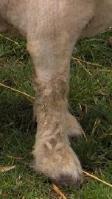 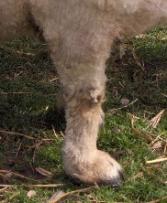 Comparing front legs of two sheep. The sheep on the left has straight legs and correct pastern angle. The sheep on the right has straight legs, but has pasterns that are too long and low. |
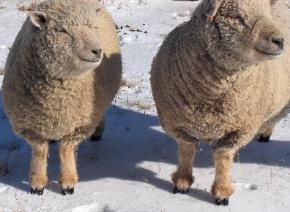 Example of ewes with narrow leg placement. |
||||
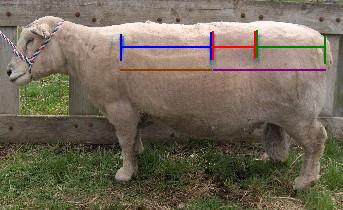 |
Markings on ram
demonstrating measurements of: Shoulder
to last rib, length
of loin, and
length of
hind
saddle. The
combined
length of
the measurements of the loin and the hind saddle
should be slightly longer than shoulder
to last
rib. |
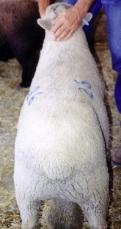 Example of "laid in"
shoulders. Shoulders should blend smoothly into the body and
not be higher than the level of the back. The width at the shoulders
should be less than the width at the hips to facilitate easy lambing.
|
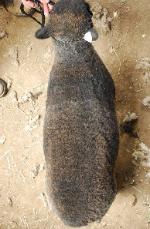 Example of wide shoulders. |
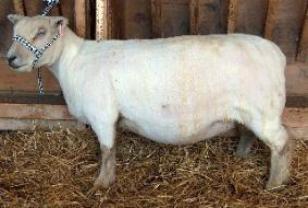 This nice ewe shows a deep chest and deep body. She is a very maternal looking ewe with a body type capable of carrying multiple lambs and with room in her body cavity to consume sufficient groceries to maintain a multiple birth pregnancy. |
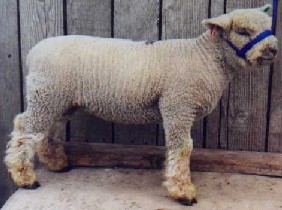 |
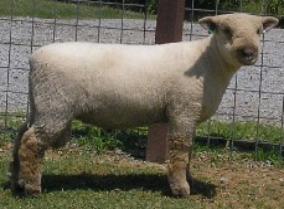 |
| The ewe and ram above are both showing very "true to type" all over conformation. Nice length, level back, straight and correct legs, nice head set, etc. | |
The rump should be wide, of medium length, and relatively flat.
The tail head carriage should be high and in a line level to the chin when the sheep is standing in a natural alert stance.
Rump wide and of medium length, with only a slight slope of the croup. Tail is large and set high on a line almost level with the chin when standing in a natural alert stance.
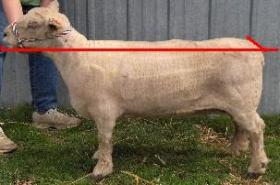 Correct tail set and croup. |
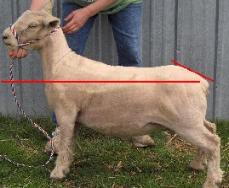 Low tail set and sloping croup. |
| The ewe on the left has a nice tail set and croup. Note the nice level line from the tail to the bottom of the jaw with the back line being the same and her tail head being level with the chin. Her slight slope of croup is correct. The ewe on the right has a much lower tail set than desired and the line is below the normal chin line even is she was in a more relaxed state. Note how much further down the line is on her tail head straight across compared to the top of the first ewe's back. Comparing the two lines, the ewe on the right is showing a much lower tail set. Also notice her croup that is sloping more than desired. The ewe on the left is a much better ewe showing the Best of Breed standard on both the rump/croup and the tail. | |
The hindquarters should be wider than the forequarters and have good width between the hipbones.
The thighs and twist should show deep and heavy muscling.
Full well-muscled hind saddle, well let down, with a deep wide muscling through the twist and legs.
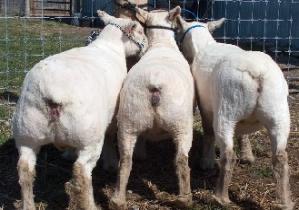 Comparison: Showing the differences in width of thighs and depth of twist. left: best, middle: moderate, right: light |
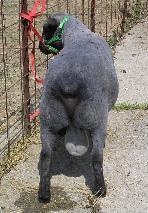 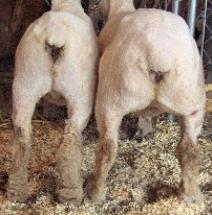 Comparison of hind saddle showing different degrees of deep, well muscling. |
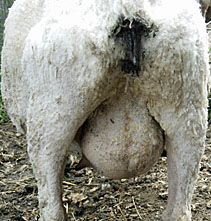 Shallow twist muscling (tail to crotch) and slight size in her rear leg width. |
|
 |
The
twist
is the depth of
muscling top to bottom of the rear leg (vertical line). Also evaluated
is the size and roundness of the rear leg line (horizontal
line). Green
lines in pictures show where the judge to determine twist length places
his hands.
Hands are placed at the top of the tail and at the crotch (green
lines). You
can see by the pictures the different sized twists for each sheep. |
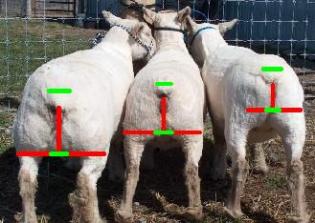 |
Rear legs should stand wide, but squarely under the sheep with a slight angle of the stifle and hocks and a slight angle of the pastern.
 Nice rear legs and a good example of a sheep standing square. |
The hoof color should be black or gray and may have white stripes. Solid white hooves are a disqualification.
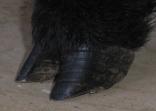 |
Hooves of the BABYDOLL sheep can vary a lot in color. The ideal hoof color is black or gray with no white on the hoof as pictured on the left on a black sheep and on the right on a white sheep. The three pictures below show different degrees of striping from heavily striped to lightly striped. Many sheep have white hooves with striping and this is totally acceptable as long as they are not solid white with no coloring at all. | 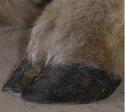 |
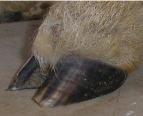 |
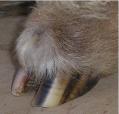 |
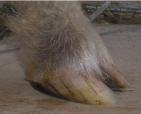 |
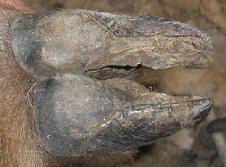 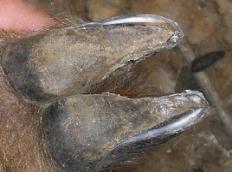 For folks new to the sheep
world the two pictures directly above show a hoof before
trimming
and
after. Many folks have
asked how to trim hooves and where to cut without getting too close to
the quick in the hoof. Hopefully these pictures will help them in
trimming their sheep's hooves. As a tip, hooves are trimmed to be level
with the soft pad in the center of the foot. Cutting below this soft
pad can cause bleeding and discomfort when the hoof is trimmed too
short.
|
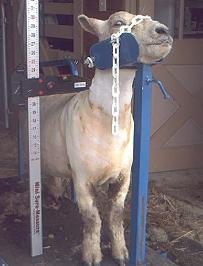 |
All
measurements are at the highest point of
the middle of the shoulder and
perpendicular to
the ground on a shorn sheep. Adult
sheep should be between 18-24" tall. Most BABYDOLL ewes fall into the
20-23" range and
most rams into the 22-24" range.
A
sheep shorter than 18" or taller than 24" will
be disqualified. These
sheep may not be registered or shown as a BABYDOLL
Southdown. Note: Sheep heights 17-18" or 24-26" if the sheep was born prior to 2025 are discriminated against. Adult sheep shorter than 17" or taller than 26" if the sheep was born prior to 2025 is disqualified. (A mini horse measuring stick, pictured to the left, is ideal for measuring BABYDOLL Southdowns.) |
Of fine texture, tight with great density and of sufficient length of staple, covering the whole of the body. Fleece should go down the hocks and knees and right up to the cheeks with a full fore top but not around the eyes or across the bridge of the nose. The fleece and hair covering around the eyes and cheeks to the muzzle should be short and not so thick as to ever cause the sheep to be "wool blind." Tear ducts should not be too woolly. Both "wool blindness" and woolly tear ducts are discriminated against. Wool of 3/8 blood or 56 to 60-skein spin count or 24-28 microns in diameter, with a springy crimp is preferred. Solid color. No more than one blemish any larger than 4-inches on any area of the animal.
Wool has been evaluated several ways over the centuries. Here are some of the terms used when speaking about wool and its qualities:
Staple length = The length of twelve months growth of fiber that is not stretched.Most old-type Southdowns - by this we mean the off-white BABYDOLL Southdowns - are evaluated as having wool that is 1/2 to 3/8 blood.
Many of the black BABYDOLL Southdowns are 1/4 blood, which means that they have coarser fleece than the off-white Southdowns. They usually have a 27 to 31 micron count, medium-coarse crimp and 2.5 to 4" staple length.
Typically the off-white wool is more valuable because it can be dyed any color.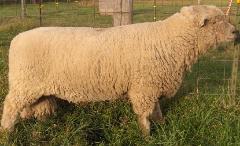 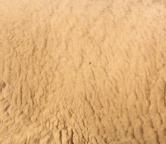 Fine fleece has a very
tiny crimp in the
fiber.
|
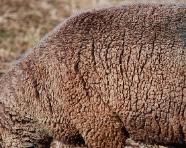 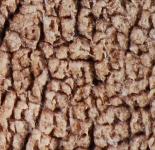 Medium fine fleece. A bit longer in staple length and slightly farther apart and larger crimp. |
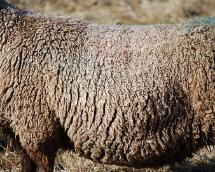 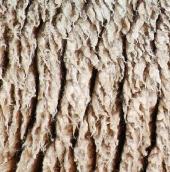 Medium fine fleece.
A bit longer in
staple length and slightly farther apart and larger crimp.
|
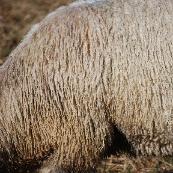 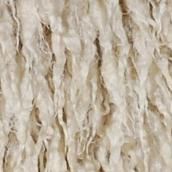 This open labeled fleece
has pretty fine
crimp but on this sample of shoulder fleece, the fibers group up and
fall open.
|
White/Off-White
The typical BABYDOLL Southdown is an off-white color with muzzle and legs that are a shade from very light tan to brown to cinnamon to mousy gray. White and off-white are terms that are often used interchangeably - some people refer to these sheep as "white" while others refer to them as "off-white." However, the NABSSAR breed standard considers them off-white.
 This lamb shows dark
coloring on the muzzle
and legs.
|
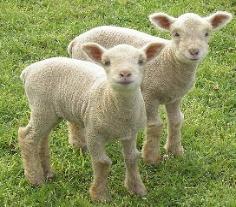 These two lambs show very
light coloring on
their muzzles and legs.
|
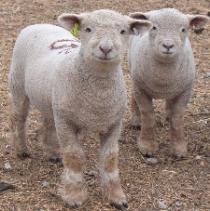 The lamb to the left shows
a mixture of
color on its legs. Color mixture is acceptable but not as
desirable as solid coloring.
|
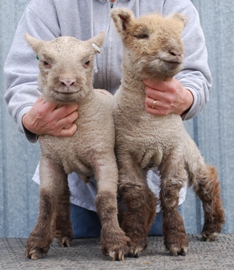 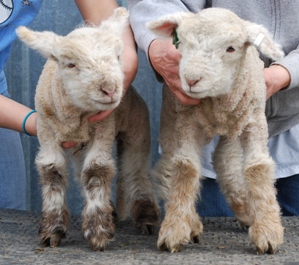 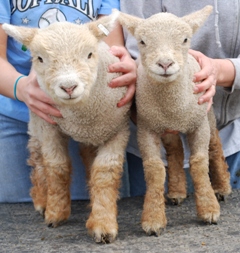 |
||
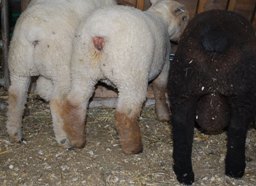 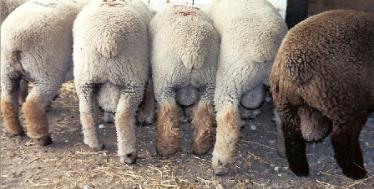 The five pictures above illustrate examples of the degrees of light to dark, different colors, and mixture of colors on lambs' legs. |
||
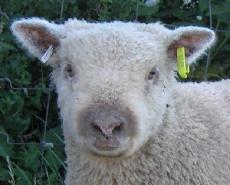 This BABYDOLL has mousy gray colored marking around the muzzle area. |
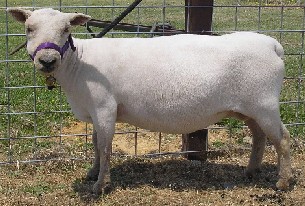 Off-white fleeced sheep after a fresh clipping and bath. |
|
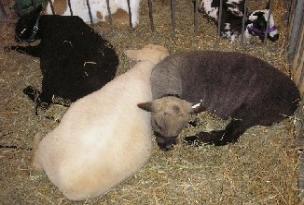 Example of common colors:
black, off-white, and black sheep that is turning gray. Note
the
gray
sheep has black legs and muzzle.
|
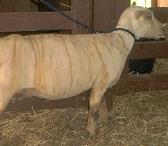 This ewe does not have
stripes. This
is just the lanolin on her seen right after shearing. These
stripes easily wash off.
|
|
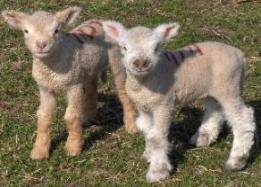 It is possible to get a
pure white lamb,
which is not registrable with the NABSSAR. The twin on the right is
from black parents and shows some white hair in its legs and muzzle
along with some darker colored hair and though less desirable than a
solid dark color it could be used cautiously in a breeding program.
If it did not have any dark hair at all, it would not be able
to
be registered with us.
|
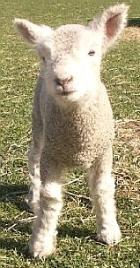 We were fortunate to
receive this picture
as an example of a solid white BABYDOLL lamb for folks wondering what
one looks like. This picture is a BABYDOLL lamb without any
pigmentation and this lamb does not meet the breed standard and is not
able to be registered.
|
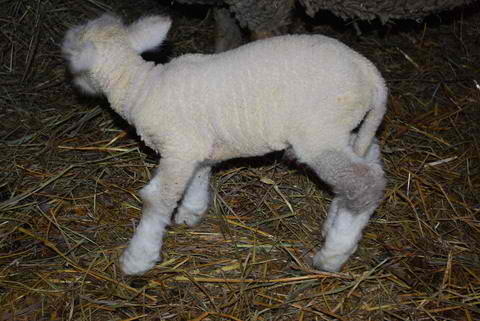 This is a picture of a
BABYDOLL predominately bright white but has a patch on the hind leg
that is the normal off-white color. This lamb does not meet the breed
standard and is not able to be registered.
|
Black is the color of the fleece at skin level in the lamb. Sometimes this color will fade to lighter shades of gray as the sheep ages, but it is still considered a black sheep. In some sheep, the sun may bleach the outer fleece to a light reddish brown color. This is only sun bleaching and is NOT considered a color.
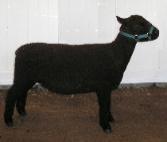 |
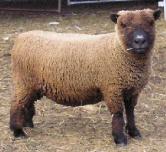 White hairs on the nose
are
common in some
dark colored sheep. This is not considered a spot as long as the skin
is still dark and not pink colored under the white hairs.
|
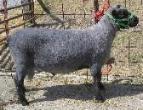 |
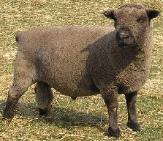 |
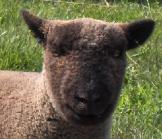 Example of an ewe with a
dark spot above her
right eye. This is a wool blemish. This sheep would not be
defined
as spotted.
|
NOTE: A blemish/birthmark (somatic mutation) is considered a fault, but the sheep can be registered. No more than one blemish/birthmark (somatic mutation) 4-inches, or less, on any area of the animal. These typically present as a solid black area on an off-white sheep and fade within a few weeks after birth.
Rams should look more masculine and are usually larger than ewes. They should be rectangular looking on a moderate frame. They must have both testicles descended. If one or both are not, it is a breed disqualification and the ram cannot be registered.
Ewes should have a broad, well attached but not pendulous udder with 2 teats. She should be capable of producing and raising twins.
The udder should be wide and well attached with two teats. Extra teats are discriminated against.
NOTES: Rams and ewes should move with freedom of gait and remain active and sound for 8-10 years. Properly managed ewes and rams should be easy keepers and maintain thrifty condition without grain if kept on good quality pasture or hay with the exception of ewes that are lactating and lambs that are in their first six months of life. When selecting replacement-breeding stock, consider selecting for sheep with the genetics to produce sound conformation that provides easy keeping and easy birthing abilities to their offspring. Breeding for undersized sheep often produces poorly muscled and unthrifty lambs. Breeding integrity is of utmost importance.
SUMMARY There are two types of "Faults" when judging the BABYDOLL Southdown, CONFORMATION FAULTS and BREED TYPE FAULTS. A good way to describe this is that conformation or structural faults are generally more serious as they affect function and reproduction. Breed type faults are more about looks, color, loose scurs, or spots. Faults can be described as very mild and hardly noticeable to severe or disqualifying faults, one reason for the point system and how it is used when judging a sheep for overall conformation and breed type. There are very few "perfect" BABYDOLL Southdowns; most have their strong points and their weak points. Careful selection of breeding stock will improve the breed as a whole.
DISCRIMINATED AGAINST (CONSIDERED A FAULT)
|
|
